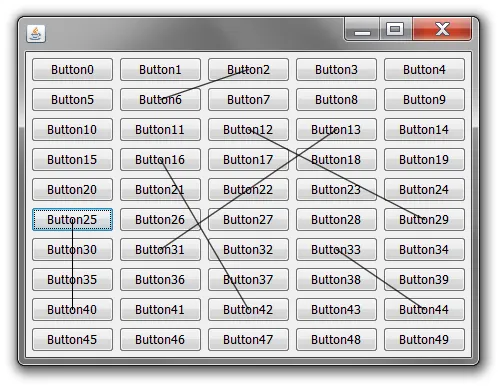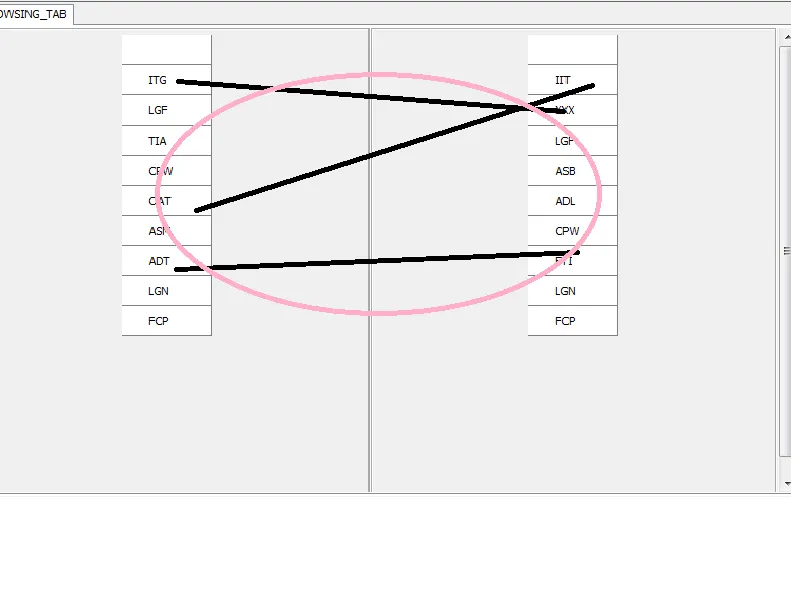您可以使用JFrame/JDialog GlassPane作为绘画区域轻松实现这一点。只需将您的自定义组件设置为框架的玻璃板,并直接在其上绘制链接即可。
您也可以使用框架/对话框的分层面板来完成相同的操作。
以下是一个小型工作示例,演示如何在玻璃板组件上绘制此类“链接”:
import javax.swing.*;
import java.awt.*;
import java.awt.event.ActionEvent;
import java.awt.event.ActionListener;
import java.util.HashMap;
import java.util.Map;
public class ComponentLinkerTest extends JComponent
{
private Map<JComponent, JComponent> linked;
public ComponentLinkerTest ()
{
super ();
linked = new HashMap<JComponent, JComponent> ();
}
public void link ( JComponent c1, JComponent c2 )
{
linked.put ( c1, c2 );
repaint ();
}
protected void paintComponent ( Graphics g )
{
Graphics2D g2d = ( Graphics2D ) g;
g2d.setRenderingHint ( RenderingHints.KEY_ANTIALIASING, RenderingHints.VALUE_ANTIALIAS_ON );
g2d.setPaint ( Color.BLACK );
for ( JComponent c1 : linked.keySet () )
{
Point p1 = getRectCenter ( getBoundsInWindow ( c1 ) );
Point p2 = getRectCenter ( getBoundsInWindow ( linked.get ( c1 ) ) );
g2d.drawLine ( p1.x, p1.y, p2.x, p2.y );
}
}
private Point getRectCenter ( Rectangle rect )
{
return new Point ( rect.x + rect.width / 2, rect.y + rect.height / 2 );
}
private Rectangle getBoundsInWindow ( Component component )
{
return getRelativeBounds ( component, getRootPaneAncestor ( component ) );
}
private Rectangle getRelativeBounds ( Component component, Component relativeTo )
{
return new Rectangle ( getRelativeLocation ( component, relativeTo ),
component.getSize () );
}
private Point getRelativeLocation ( Component component, Component relativeTo )
{
Point los = component.getLocationOnScreen ();
Point rt = relativeTo.getLocationOnScreen ();
return new Point ( los.x - rt.x, los.y - rt.y );
}
private JRootPane getRootPaneAncestor ( Component c )
{
for ( Container p = c.getParent (); p != null; p = p.getParent () )
{
if ( p instanceof JRootPane )
{
return ( JRootPane ) p;
}
}
return null;
}
public boolean contains ( int x, int y )
{
return false;
}
private static ComponentLinkerTest linker;
public static void main ( String[] args )
{
setupLookAndFeel ();
JFrame frame = new JFrame ();
linker = new ComponentLinkerTest ();
frame.setGlassPane ( linker );
linker.setVisible ( true );
JPanel content = new JPanel ();
content.setLayout ( new GridLayout ( 10, 5, 5, 5 ) );
content.setBorder ( BorderFactory.createEmptyBorder ( 5, 5, 5, 5 ) );
frame.add ( content );
for ( int i = 0; i < 50; i++ )
{
final JButton button = new JButton ( "Button" + i );
button.addActionListener ( new ActionListener ()
{
public void actionPerformed ( ActionEvent e )
{
link ( button );
}
} );
content.add ( button );
}
frame.setDefaultCloseOperation ( JFrame.EXIT_ON_CLOSE );
frame.pack ();
frame.setLocationRelativeTo ( null );
frame.setVisible ( true );
}
private static JButton last = null;
private static void link ( JButton button )
{
if ( last == null )
{
last = button;
}
else
{
linker.link ( last, button );
last = null;
}
}
private static void setupLookAndFeel ()
{
try
{
UIManager.setLookAndFeel ( UIManager.getSystemLookAndFeelClassName () );
}
catch ( ClassNotFoundException e )
{
e.printStackTrace ();
}
catch ( InstantiationException e )
{
e.printStackTrace ();
}
catch ( IllegalAccessException e )
{
e.printStackTrace ();
}
catch ( UnsupportedLookAndFeelException e )
{
e.printStackTrace ();
}
}
}
结果如下:
(只需依次单击任意两个按钮即可将它们链接在一起)

附:要使线条更粗,可以在绘画时更改描边:
g2d.setStroke ( new BasicStroke ( 5f ) );

